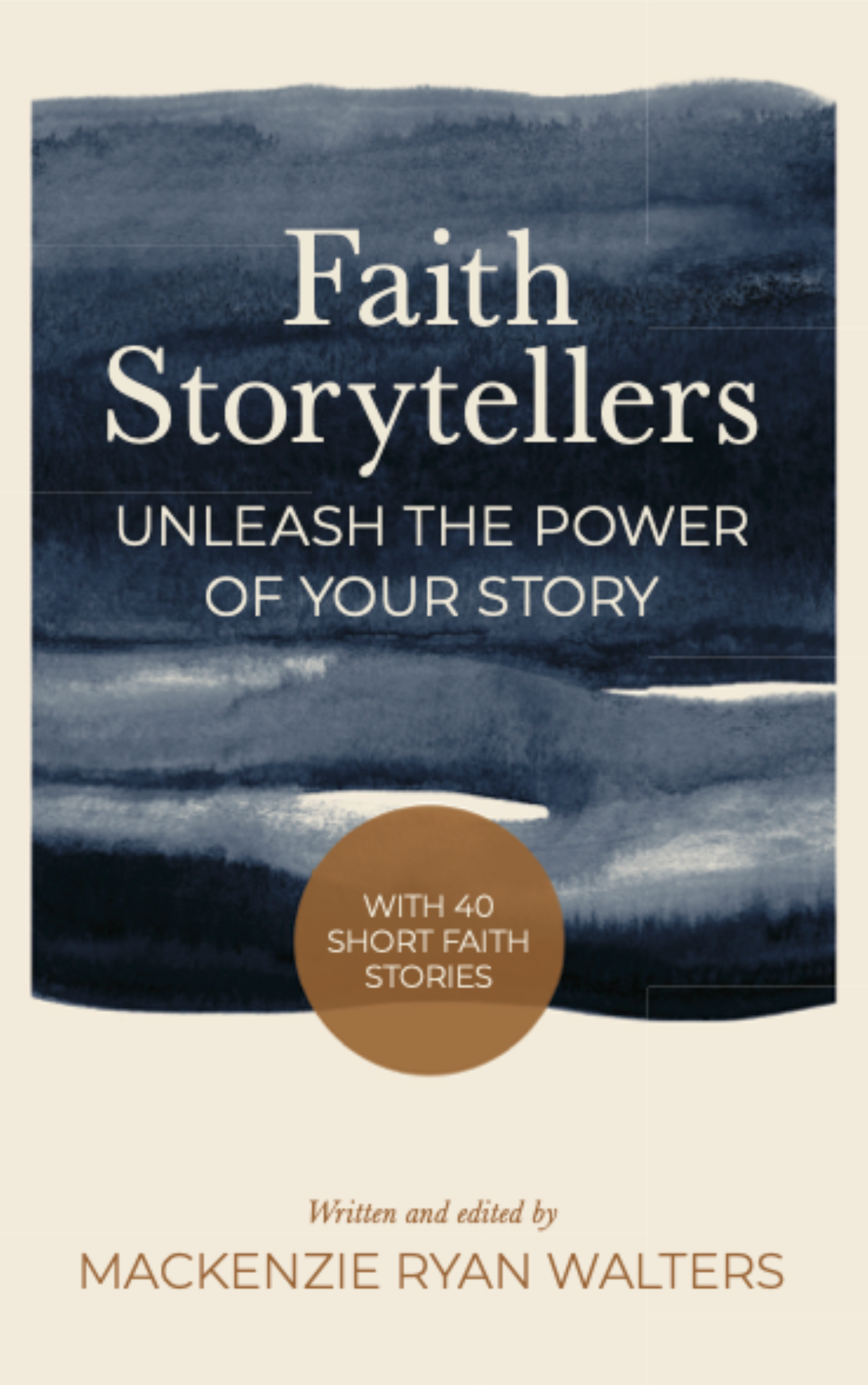Your guide on how to write a testimony or faith story to share
Learn how to write a testimony using the Faith Storytellers Framework. Our 5 steps process will teach you how to organize your story.
How to write a testimony using the Faith Storytellers Framework
At Faith Storytellers, we understand how challenging it can be to have a story you want to share but you’re unsure how to organize, structure, or write your story. If you’ve ever struggled with how to write a testimony, then you’ll find the following advice on how to organize and revise it helpful.
It’s the same writing and editing process we teach and ask al writers to follow when they submit stories to share at Faith Storytellers. It’s the process author Mackenzie Ryan Walters used when writing her book: “Faith Storytellers: Unleash the Power of Your Story.”
Before you begin, it can be helpful to read through a few stories and scan through additional resources we provide here at Faith Storytellers. It’s modeled after what Peter said in the book of Acts, when Peter was asked about a decision he made about how to live out his faith: “Starting from the beginning, Peter told them the whole story.”
Before you write your faith story or Christian testimony
Read a few testimony examples on our website. We regularly share personal faith stories.
Download our story cheat sheet. Use it as a quick guide for how to organize your story.
The 3 Act Structure: How to write your Christian testimony
Our Faith Storytellers Framework allows you to craft your personal testimony story in a way that encourages readers or listeners to "lean in" and learn more.
Our approach is based on the narrative structure you find in the Bible, which most modern books, movies, and plays replicate: The three-act structure.
Act I: Beginning that shows your before
The first part of your story will share your “before” experience. This is the “normal world” before your view of God changed how you view your life and choose to live today.
Example: A moment that epitomizes your life and belief before you met Jesus.
Example: Before you learned about a specific facet of God’s character. If your story is about the death of your dad, your story might be a moment you remember or the morning of the day before he passes.
Act II: Middle with change, shows your struggle
The middle part of your story is where your main character — that’s you! — struggles in a way that eventually changes their worldview. This can be a physical struggle, such as a car accident leading to chronic pain, an emotional or mental health struggle, or a spiritual struggle. The best stories often contain elements of each.
In the book of Genesis, Jacob wrestles with God and he’s renamed Israel. His new name gives him a new identity. Israel means “he who wrestles with God.” At Faith Storytellers, we believe that wrestling with God is a critical part of your story. It gives you the authority to share your story because you’ve personally struggled through the challenges of faith.
Example: A moment that epitomizes how you engaged God as you wrestled with whether to believe Jesus is the Messiah. Not all believers have “Road to Damascus” moments; many have slower journeys to belief that simmer for a long time.
Example: If the story is about your dad’s death and your grief, you may describe a moment sitting at his bedside saying goodbye, or crying out to God after he passes, or a few years later when your first child is born and your grief at your father not being there is overwhelming.
Act III: Ending that resolves your beginning through your middle
Your ending needs to tie back to the beginning of your story in order to reach a sense of resolution or completeness. While you're still living your story, as humans, we crave a sense of resolution or redemption. At one point, you may have wanted your story to have turned out differently, and that's understandable. The resolution is accepting the wayyour story turned out and how God was with you through it.
Example: A moment that epitomizes your belief in Jesus today. This may be a moment of worship, gratitude, or serving others, to name a few.
Example: If your story is about your dad’s death, your ending will tie back to a spiritual truth that God revealed to you along the way. At this point in your story, God’s truth is fully integrated into who you are and how you live. In Mary’s story, she writes about how she comforted two children at a funeral because she knows what it’s like to lose a father at such a young age.
Personal faith statement: What you personally know to be true now about God
At the very end of your story, end with a personal belief. Try finishing this sentence: “What I know to be true about God that I didn’t before is …” Keep this short, 1-2 sentences, and keep it in first person using “I” or “me.” Remember, you’re not teaching or preaching; you're simply sharing your personal experience as a witness to God’s love and grace.
Example: “Looking back, I know Jesus is real and was pursuing me because that’s who he is, the good shepherd who will look for every last one of his lost sheep because he loves them so much.”
Example: In Mary’s story, she ties the statement back to her father, who’s now in heaven, by saying: “Yet “God continues to provide forgiveness throughout my journey so I may be reunited with him one day — just like he did for my Daddy.” Your point may be different; for example, maybe through your grief, you realized God’s truth of the Beatitudes when Jesus says in Matthew 5:4: “Blessed are those who mourn, for they shall be comforted.”
There are many reasons to write a Christian testimony, whether it’s for church, to share with your small group, or to include in a book you’re writing. Many faith storytellers share the spiritual growth and healing process that comes from writing your story, praying through it with God, and sharing it with one trusted person.
How to write a testimony: The Faith Storytellers Framework
Step 1: Pray about which story to tell
Reflect on what true, first-person story to share about your faith. This is a story about your personal relationship with God and how it’s changed or grown during a specific time in your life.
Your story does not have to be about your life's deepest, darkest moment. We’ve had storytellers say they wanted to write one story. After praying through it, God led them to tell a different story instead.
Step 2: Outline your three scenes. Each scene is a specific moment in your life.
Now it’s time to briefly outline your story. Create three sections or scenes. These scenes should be chronological, although the timeline may vary. For example, you may start the first scene when you’re 12 or 25, the second scene when you’re 26, and the last scene when you’re 57. It can be helpful to add a subhead above each section:
Scene 1 Subhead
Beginning (typically the opposite of your ending)
Scene 2 Subhead
Middle where something changes
Scene 3 Subhead
Ending that brings resolution and shares a personal statement about your faith (“What I know to be true about God that I didn’t before …”)
You’ll refine your faith statement (your ending). For now, make sure it reflects the story you’re telling in all three scenes.
For example, if your story is about God’s comfort during grief, one of the three scenes should focus on a moment when you were experiencing loss. Your story doesn’t have to be dark, but we want it to be deep.
Step 3: Create a narrative sequence in each scene by adding action and reaction
Each scene will open with a brief description of where you were (location) and when the scene occurred (age, decade, year, etc.) Like a movie that briefly flashes an image of the scene before jumping to the action, you're opening description allows your readers to quickly understand the context needed to immerse themselves into your story fully
Next, you'll have the scene's action, which is the bulk of what happened that makes this scene so moving and memorable. Because this is a short story (not a memoir or movie!), you’ll “zoom in” on the action scene.
Each scene will also end with your reaction, which is how you felt about what happened in the scene. Describe and name your emotions (which goes against conventional writing wisdom, but in the storytelling form we teach, it works because it helps an audience quickly identify and empathize with your feelings. The point of Faith Storytellers is connection.
It will look something like this:
Scene 1: Beginning (opposite of ending)
Weave in description of where you are (time and place)
Action (what happened)
Reaction (how you felt about what happened, name your emotion)
Scene 2: Middle with change
Weave in description of where you are (time and place)
Action (what happened)
Reaction (how you felt about what happened)
Scene 3 Middle with change
Weave in description of where you are (time and place)
Action (what happened)
Reaction (how you felt about what happened)
Personal faith statement.
Try finishing this sentence: “What I know to be true about God that I didn’t before is …”
At this point, your personal faith statement may be long! You may identify three, five, or 17 ways that God taught you something knew about who he is as you lived your story. For the benefit of the reader or listener, you’ll want to narrow this down to one main point. In the short story format we teach at Faith Storytellers, your story is actually more powerful and meaningful if you share ONE point at the end.
Otherwise, it’s far too easy for whoever is receiving your story to get confused or distracted — with so many points, they aren’t sure which one is the most important. Remember, you have many, many stories to share, and narrowing your faith statement down to 1-2 sentences is part of learning how to write a testimony.
Step 4: Pray through your story. Ask God to reveal details about where he was or how he loved you during your story.
Now, you’ll revise even more. Did you know that writing is really about revising? That’s the secret!
The best writers continue to revise. Seriously, that’s the trick. Just keep revising, improving, adding, and subtracting. One draft may see you expand your story in order to fully see what’s there, and the next draft may have you reduce your story to the most powerful parts and descriptions. Without expanding it first, it would have been difficult to select the parts to keep and the parts to cut away.
For example, instead of stating, “God did this,” describe what happened and how you reacted. As the old writing adage goes, “Show, don’t tell.” If you haven’t already, it’s helpful to read through a few faith stories to see how others did it. Take a few moments to explore faith stories by topic.
It’s important to pray through your story and ask God humbly to show you where he was in each of your scenes. Ask him: Where were you? How did you reveal yourself to me? How did God respond when you wrestled with him?
It’s normal to feel nervous or uncertain when you share yourself and your struggles with God. It’s also natural to feel vulnerable as your story will likely reveal your imperfections. That is the truth, however: We are weak; God is strong. We are human; God is divine. To be human is to be imperfect. It’s our struggle with our imperfection that allows us to seek out our perfecter and choose God.
Refine your faith statement at the end. This is your “mic drop” moment. Narrow down your statement to ONE point that you believe your story is about. Write it in 1-2 sentences.
This one main point about what you know to be true about God now, looking back, will help you refine your story. In the Faith Storytellers book, we discuss how God is like the wind: You can’t see him, but based on the evidence of how the grass sways or how a calm settles in after a storm, you can see that he is there.
Step 5: Prepare your faith story to share
The final step is to prepare your story to share. In our experience, the best writing is about revision, and the best speaking is about practice. That’s why we encourage you to continue to polish your story independently and with a trusted friend or loved one.
If you’re writing your story:
Read it slowly out loud to yourself. You’ll catch things you want to improve that you didn’t see when you read it silently.
Send it to a friend and ask them to share things that resonated with them about your story, as well as things that were unclear. It’s important to share the specific type of feedback you want!
Check speller, grammar, and your publishers’ writing style. Every publisher uses a different style. At Faith Storytellers, we use this one.
If you’re speaking your story:
Practice saying your story out loud from memory if you plan to speak it (you don’t have to memorize it word-for-word, just the main points).
Practice speaking your story from memory in front of a friend. Ask them to share things that resonated with them about your story, as well as things that were unclear. It’s important to share the specific type of feedback you want!
Public speaking may feel intimidating, but it doesn’t have to be. Check out our seven public speaking tips.
After you write your testimony, share it with Faith Storytellers!
We invite you to share your Christian testimony with our readers as we publish short stories and testimonies that reflect God's love and grace. Submissions should be original, true stories between 500 and 2,500 words, written in a conversational style, and free of preaching or teaching. We want to share your personal story in the format we teach: The witness you are to God’s love and saving grace.
There may be other ways to share your story. Consider praying and asking God about your next steps. If you’ve learned how to write a testimony for church, for example, consider sharing your story with your pastor and ask how they may use it for God’s glory.




